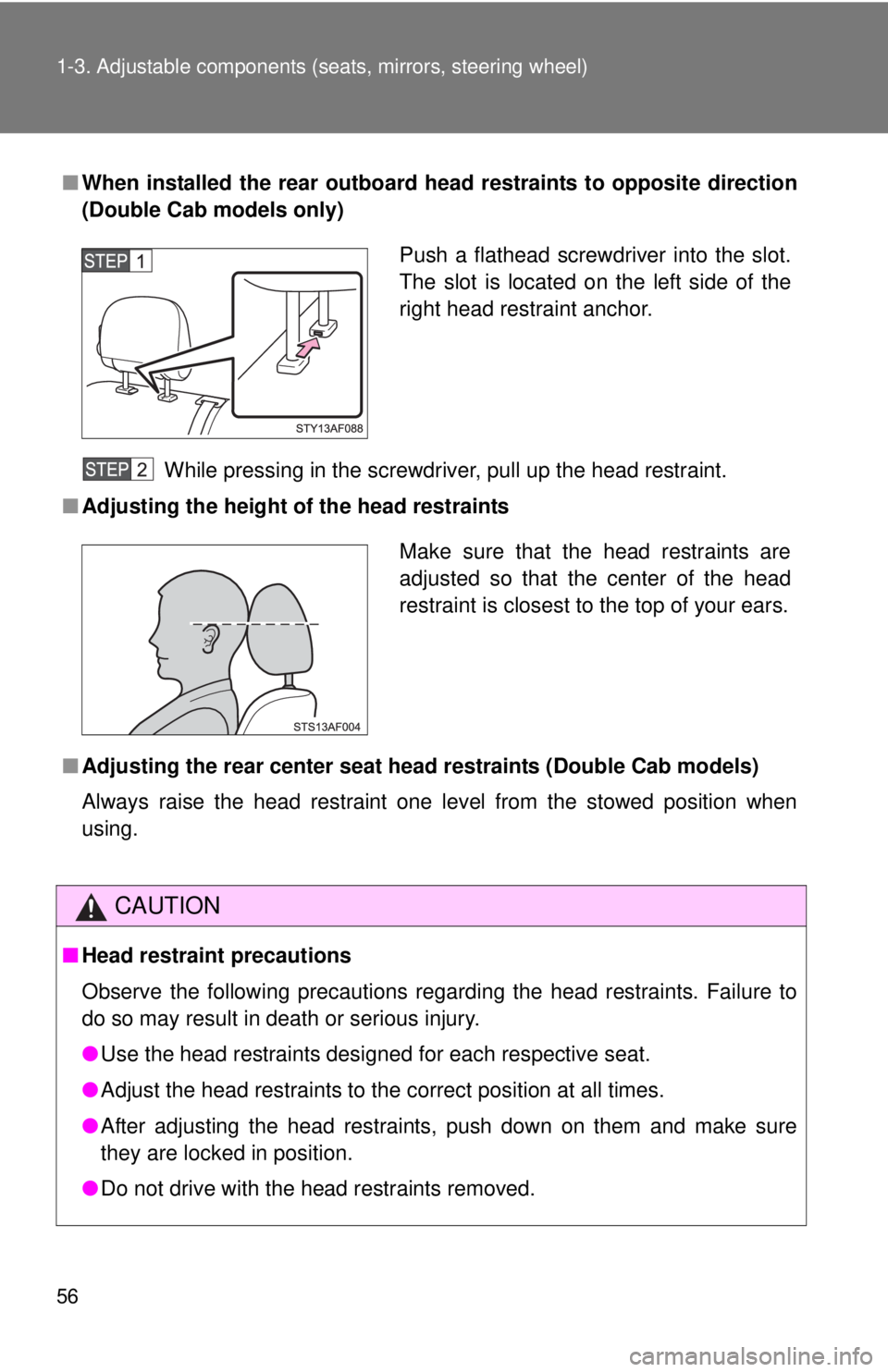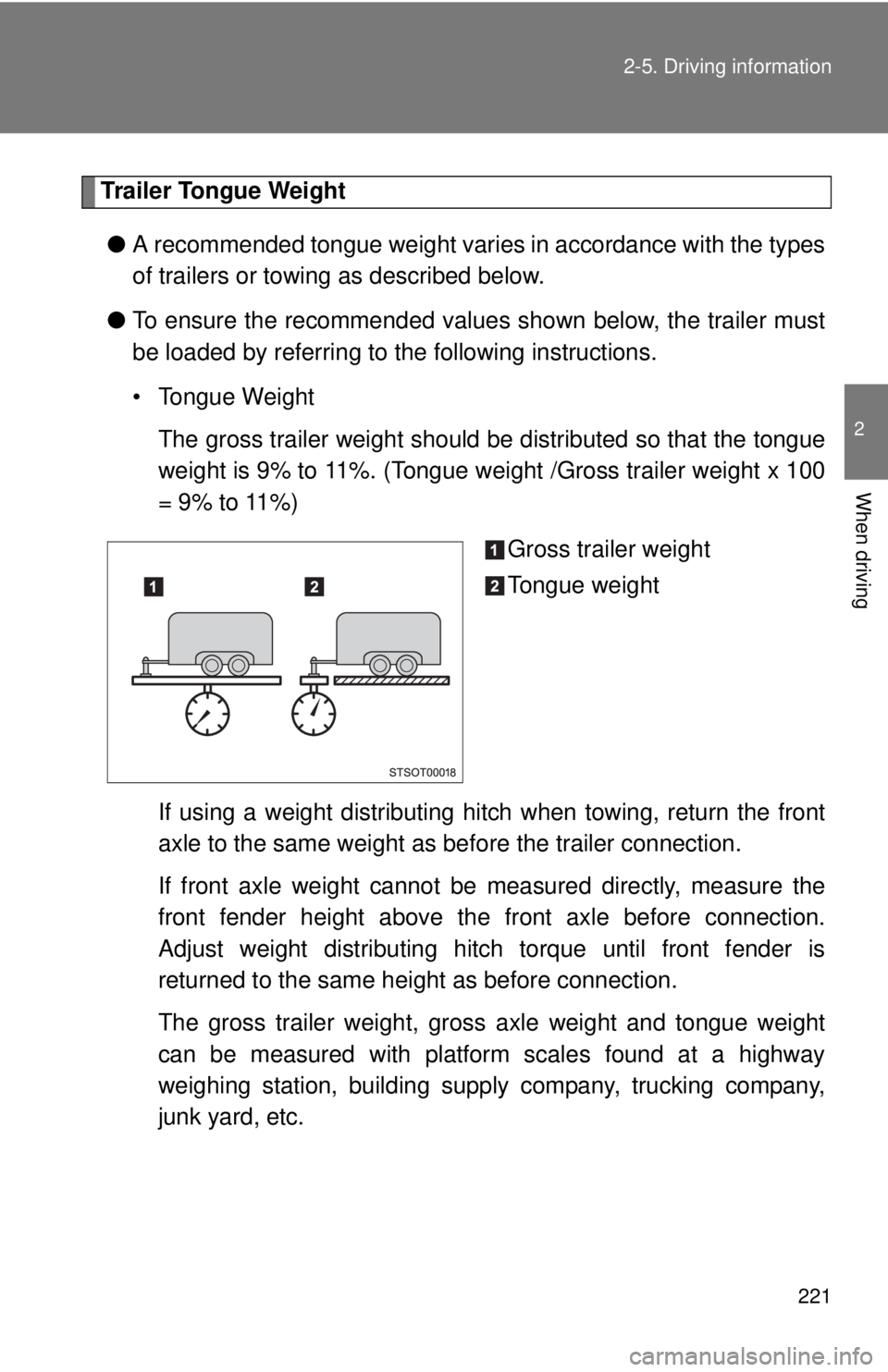Page 56 of 590

56 1-3. Adjustable components (seats, mirrors, steering wheel)
■When installed the rear outboard h ead restraints to opposite direction
(Double Cab models only)
While pressing in the screwdriver, pull up the head restraint.
■ Adjusting the height of the head restraints
■ Adjusting the rear center seat head restraints (Double Cab models)
Always raise the head restraint one level from the stowed position when
using.
CAUTION
■ Head restraint precautions
Observe the following precautions regarding the head restraints. Failure to
do so may result in death or serious injury.
●Use the head restraints designed for each respective seat.
● Adjust the head restraints to the correct position at all times.
● After adjusting the head restraints, push down on them and make sure
they are locked in position.
● Do not drive with the head restraints removed.
Push a flathead screwdriver into the slot.
The slot is located on the left side of the
right head restraint anchor.
Make sure that the head restraints are
adjusted so that the center of the head
restraint is closest to the top of your ears.
Page 58 of 590
58 1-3. Adjustable components (seats, mirrors, steering wheel)
Seat belt pretensioners (front seats)
The pretensioner helps the seat
belt to quickly restrain the occu-
pant by retracting the seat belt
when the vehicle is subjected to
certain types of severe frontal
collision or a vehicle rollover.
The pretensioner may not acti-
vate in the event of a minor frontal
impact, a side impact or a rear
impact.
■Adjusting the height of the belt (front seats)
Up
Move the height adjuster up as
needed until you hear a click.
Down
Push the lock release button
and slide the height adjuster
down.
Page 66 of 590
66 1-3. Adjustable components (seats, mirrors, steering wheel)
Adjusting the height of rear view mirror
Adjust the height of the rear view
mirror by moving it up and down.
Auto anti-glare inside rear view mirror (type B)
In automatic mode, sensors are used to detect the headlights of
vehicles behind and automatical ly reduces the reflected light.
Turns automatic mode on/off
The indicator comes on when
automatic mode is turned on.
The mirror will revert to the
automatic mode each time the
engine switch is turned on.
Page 197 of 590
197
2
When driving
2-5. Driving information
Off-road precautions (4WD models and PreRunner)
Off-road vehicle feature
● Specific design characteristics give it a higher center of gravity
than ordinary passenger cars. This vehicle design feature causes
this type of vehicle to be more likely to rollover. And, it has a signif-
icantly higher rollover rate than other types of vehicles.
● An advantage of the higher ground clearance is a better view of the
road allowing you to anticipate problems.
● It is not designed for cornering at the same speeds as ordinary
passenger cars any more than low-slung sports cars are designed
to perform satisfactorily under of f-road conditions. Therefore, sharp
turns at excessive speeds may cause rollover.
This vehicle has higher ground cl earance and narrower tread in rela-
tion to the height of its center of gravity to make it capable of per-
forming in a wide variety of off-road applications.
Page 221 of 590

221
2-5. Driving information
2
When driving
Trailer Tongue Weight
● A recommended tongue weight varies in accordance with the types
of trailers or towing as described below.
● To ensure the recommended values shown below, the trailer must
be loaded by referring to the following instructions.
• Tongue Weight
The gross trailer weight should be distributed so that the tongue
weight is 9% to 11%. (Tongue weight /Gross trailer weight x 100
= 9% to 11%)
Gross trailer weight
Tongue weight
If using a weight distributing hitch when towing, return the front
axle to the same weight as before the trailer connection.
If front axle weight cannot be measured directly, measure the
front fender height above th e front axle before connection.
Adjust weight distributing hitch torque until front fender is
returned to the same height as before connection.
The gross trailer weight, gross axle weight and tongue weight
can be measured with platform scales found at a highway
weighing station, building supply company, trucking company,
junk yard, etc.
Page 228 of 590

228 2-5. Driving information
Release the parking brake (and also the brake pedal on vehi-
cles with an automatic transmission), and slowly pull or back
away from the wheel blocks. Stop and apply the brakes.
Have someone retrieve the blocks.
■ Matching trailer ball height to trailer coupler height
■ Before towing
Check that the following conditions are met:
●Ensure that your vehicle’s tires are properly inflated. ( P. 532)
● Trailer tires are inflated according to the trailer manufacturer’s recom-
mendation.
● All trailer lights work as required by law.
● All lights work each time you connect them.
● The trailer ball is set at the proper height for the coupler on the trai\
ler.
● The trailer is level when it is hitched.
Do not drive if the trailer is not level, and check for improper tongue
weight, overloading, worn suspension, or other possible causes.
● The trailer cargo is securely loaded.
No matter which class of tow hitch
applies, for a more safe trailer hookup,
the trailer ball setup must be the proper
height for the coupler on the trailer.
Coupler
Trailer ball
Page 518 of 590
516
6-1. Specifications
Maintenance data (fuel, oil level, etc.)
Dimensions2WD models except PreRunner
*: Unladen vehicle
Cab type
Access Cab
Double CabExcept
X-RunnerX-Runner
Overall length 208.1 in.
(5285 mm) 208.5 in.
(5295 mm) 208.1 in.
(5285 mm)
Overall width 72.2 in.
(1835 mm) 74.0 in.
(1880 mm) 74.6 in.
(1895 mm)
Overall height*66.1 in.
(1680 mm) 65.6 in.
(1665 mm) 66.1 in.
(1680 mm)
Wheelbase 127.4 in. (3235 mm)
Front tread61.0 in.
(1550 mm) 62.2 in.
(1580 mm) 61.0 in.
(1550 mm)
Rear tread 61.0 in.
(1550 mm) 62.2 in.
(1580 mm) 61.0 in.
(1550 mm)
Page 519 of 590
517
6-1. Specifications
6
Vehicle specifications
4WD models and PreRunner
*1:Unladen vehicle
*2:P265/60R18 tires
Cab typeAccess Cab
Overall length
208.1 in. (5285 mm)
Overall width 74.6 in. (1895 mm)
Overall height*170.3 in. (1785 mm)
Wheelbase127.4 in. (3235 mm)
Front tread 63.0 in. (1600 mm)
63.4 in. (1610 mm)*2
Rear tread 63.2 in. (1605 mm)
63.6 in. (1615 mm)*2
Cab typeDouble Cab
With short deckWith long deck
Overall length 208.1 in. (5285 mm) 221.3 in. (5620 mm)
Overall width 74.6 in. (1895 mm)
Overall
height
*1
2.7 L 4-cylinder
(2TR-FE) engine70.3 in. (1785 mm)
4.0 L V6
(1GR-FE) engine70.1 in. (1780 mm)
Wheelbase
127.4 in. (3235 mm) 140.6 in. (3570 mm)
Front tread 63.0 in. (1600 mm)
63.4 in. (1610 mm)*2
Rear tread 63.4 in. (1610 mm)
63.8 in. (1620 mm)*2